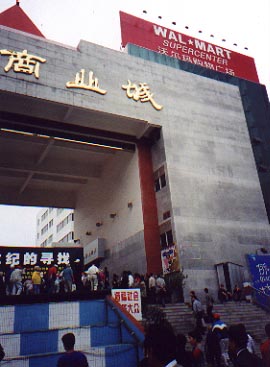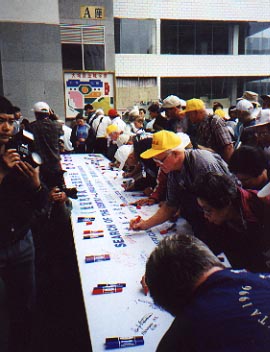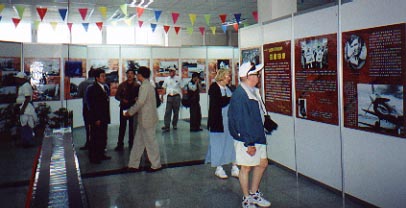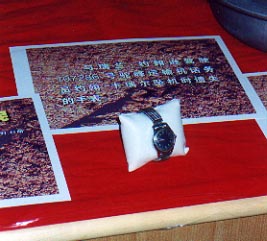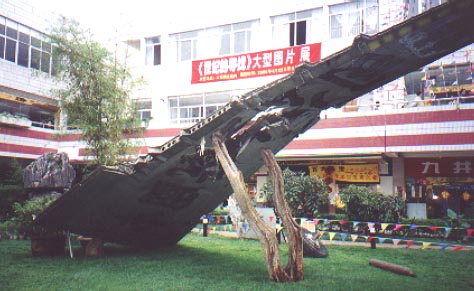UPDATE - STILL UNDER CONSTRUCTION
FROM: Fletcher Hanks, Box 560, Oxford, MD 21654
DATE: March 14, 1997
Now that I have received all of the 73 pictures that Mr. Ge took when he went to CNAC #53 the end of January 1997, my opinion of the demise of the crew has changed. I think that both that pilots were killed in the crash. The radio operator may have survived the crash because his seat was about 5 feet back from the pilots. The pictures do not show damage to that area. I will give comments on the pictures that are reproduced on the following pages.
Pictures #1 and 2 were taken from Pete Goutiere's plane the first of May 1943. The tail section was then attached to the fuselage and the right wing was in one piece and attached to the fuselage. The cockpit was to the right of the fuselage but I did not know it was inverted, during the crash, until I received Ge's entire collection of pictures.
#1
#2
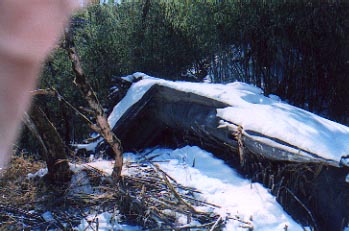
#6 -- Collapsed Vertical Tail
|
#6 shows the collapsed vertical tail that holds the rudder. Undoubtedly structural damage when it crashed caused it to fall after 1945. It was vertical then. It shows where the side of the plane was cut open to remove cargo. I doubt if the stone-age people would do such a neat job. Perhaps the Burma NDA (New Democratic Army) used modern tools.
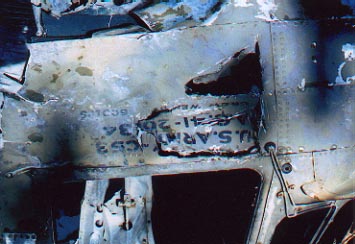 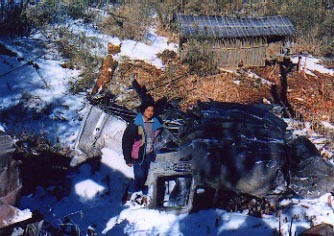
#3 -- Cockpit                       #4 -- Mr. Ge's nephew by cockpit #4 -- Mr. Ge's nephew by cockpit
|
When I received the first pictures (#3) of the cockpit, it looked as if Jim Fox would of survived. Today I received #4 which shows Mr. Ge's nephew standing by the cockpit. Then I realized that the cockpit was 10 feet in front of the rest of the plane and truned up-side down. Another picture, not shown because it is too dark, reveals considerable damage to the cockpit above Jim Fox's head. i can't see his seat belt. The head rest is still there, gear handle up, pitch control full forward and throttles in cut off position. I will send the picture to Pete Goutiere for his analysis, as he was an FAA inspector for many years.
#7 is of the underside of the right wing with CNAC in Chinese. The flap is full down.
#7
#8 is of a tree that grew through the fuselage and two government workers are standing on the plane. There is a warning, written in red, in the language of the Lusi tribe prohibiting removal of anything from the wreck. Just below it shows how someone stripped the skin off the fuselage. I assume it took place before the sign was posted.
#8
#9 Peasants who are guarding CNAC #53 for the Hpimaw Police. Wang Er, on the left is holding a bow and arrow. The arrow is tipped with liquid poison that the ethnic group left behind. The shack is where the guards sleep and eat. Ge said he almost froze at night because he had not planned on going there so he had no food or extra clothes. They arrived too late to get back to Hpimaw Pass.
#9
We want to arrange for the guards to receive 3 guns instead of one in case the warriors come back in force. They need hand-held radios so they can stay in contact with the Hpimaw Police Station. One guear has been there for 50 days. He wants a day off to go see his family.
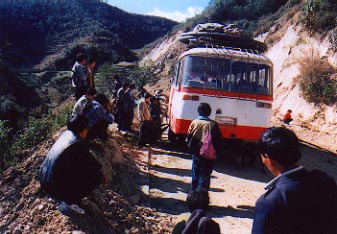
#10 -- Pima Pass Bus
|
#10 The Hpimaw Pass (Pima Pass today) Bus has engine trouble. Apparently some one put water in the oil by mistake. Or is this just a rest stop?
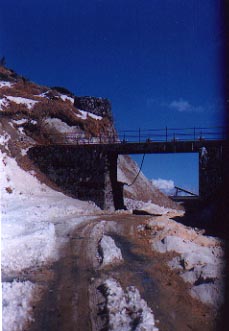
#11 -- Pima Pass, China
|
#11 Hpimaw Pass (Pima Pass today) where the CNAC planes funnelled through going both ways at 10,500 feet. It was an important check point. We called it V-Pass.
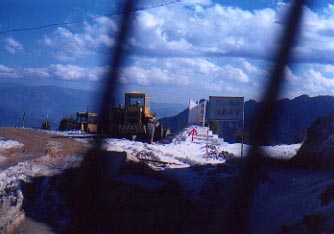
#12 -- Pima Pass, China
|
#12 The Japanese pillbox (arrow) in Hpimaw Pass (Pima Pass today). Now it is a monument to remind all how far north in China the Japs controlled during WWII. CNAC #53 is approximately 4 miles south (to the left) at 100 feet less altitude. We assumed the Japs would not shoot us down because they would immediately get blown off the mountain by aerial bombs. We were right.
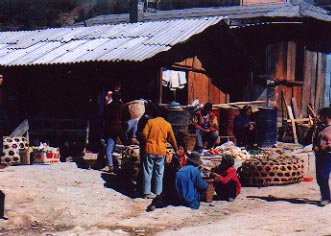
#13 -- PianMa, China
|
#13 This is the town of PimaMa. Chinese lumberjacks who cut the Burma forests live in this small town. It shows the woven bamboo cages to keep the birds that are for sale. It is a wide open town with outlaws, prostitutes, drunks, gamblers carrying pistols like it was in the US wild west. Mr. Ge writes that, "As soon as we got to the inn, several women smoking cigarettes came over". That is as far as his story went.
The bus took Mr. Ge, Mr. Yang and Mr. Ge's nephew from Lushui to PimaMa (44 miles). The next day the police took them in their vehicle into Burma 12.5 miles to within 1.5 miles of CNAC #53. Then it took them 3 hours to climb up to the plane. The west side of the mountain range is very steep. It requires more climbing than walking.
Pete Goutiere writes that, "after Jim Fox crashed, he flew over the plane every day and never saw any signs of life. One day he saw an enormous black bear near the plane". Maybe the bear explains why ther was no trace of the crew at the plane.
For 30 years, all Chinese sources had told me that it was too dangerous to go where the plane was because a dangerous stone-age ethnic group of head hunters controlled the area.
In July 1997, with the advice of a former missionary of that area, I contacted the Burma ethnic groups representative in exile, in the Washington area, to ask for safe passage through their area. I gave him the coordinates of the plane, determined by the space shuttle Columbia. He immediately made contact with his representative in Thailand and received clearance for me to travel on horse back to the plane from Thailand through the Golden Triangle (opium country). I was scheduled to go in October but I could not finance it. The Burmese undoubtedly went to CNAC #53 after receiving its exact location.
The best effort our team could finance was to send Mr. Ge and Mr. Yang, in January, to the PimaMa Pass Police to request permission for a trip to the plane in the June. When they arrived there, the police knew about the plane and had it guarded to keep it from being looted further. The police volunteered to take them to the plane the next day.
Apparently, the Burmese ethnic group, in the area of the plane, tried to sell the cargo of wolfram worth $20,000 by the quotation in the Wall Street Journal and the NDA found out about it and notified the PimaMa Pass Police about it. The police took control of the plane and stationed guards on it. The Chinese government sent in surveyors who in December determined CNAC #53 was inside of China by 100 yards.
Lushui is planning a celebration for having found CNAC #53 in their counrty. Also they'll have a memorial service for the crew members. Among those who are expected to be there are:
1- The CNAC #53 team: Ge Shuya, Yang Shunfa, Judith Mills, our interpreter and consultant, and Fletcher Hanks.
2- Pamela Smith, relative of Jim Fox. Relatives of the other two crews if we can find their families.
3- Representatives of the PROC and the US.
4- Pete Goutiere, who saw the plane crash.
5- One of the AVG Flying Tigers who stopped the Japanese in the Battle of the Salween Gorge.
6- Steve Kusak who accompanied Red Holmes and me on a walking expedition in an attempt to reach #53 in 1944.
7- Chinese mechanics who kept the CNAC planes in the air during WWII.
It is anticipated that the tour will fly from Kunming to Dali, two nights there and the following day drive by minibus, like the one in the picture, to Lushui (approximately 100 miles). Five nights in the Lushui area, including a bus trip to PimaMa Pass and the town of PimaMa. Those who want to will walk and climb the 1.5 miles to CNAC #53 and spend a night at the plane.
When we leave Lushui we take the bus ride to Paoshan (approximately 80 miles), then 18 miles on the Burma Road over the bridge at the Salween River Gorge, one night at Paoshan and then fly back to Kunming.
We'll stay at the Holiday Inn or Green Lake Hotel while in Kunming for two days. Two nights of feasts with dignitaries.
Anyone interested in learning more about this tour should contact me immediately. it will be a short tour of 8 days from Kunming. West of Kunming, the sleeping facilities are crude by Americna standards and when traveling by bus, a relief station might be the nearest tree or bush.
I realize that some of the people on my mailing list have no interest in this project. The reports are expensive and take considerable time. Therefore, those who do not send in $5 to pay for the future reports will be dropped from the mailing list. Of course, those who have supported my effort by buying T-shirts and those who have contributed to the "C-53 CNAC #53 Fund" will continue to receive all reports.
CNAC #53 will be restored as an international memorial for those 1800 who died during WWII in flying freight to China from India. It is obvious that the guards need help; please help if you can. Next report: more pictures with captions.
to be continued...
|









